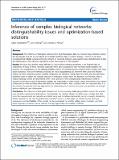Por favor, use este identificador para citar o enlazar a este item:
http://hdl.handle.net/10261/44501COMPARTIR / EXPORTAR:
 SHARE SHARE
 CORE
BASE CORE
BASE
|
|
| Visualizar otros formatos: MARC | Dublin Core | RDF | ORE | MODS | METS | DIDL | DATACITE | |

| Título: | Inference of complex biological networks: distinguishability issues and optimization-based solutions |
Autor: | Szederkényi, Gábor CSIC ORCID; Banga, Julio R. CSIC ORCID ; Alonso, Antonio A. CSIC ORCID | Fecha de publicación: | 28-oct-2011 | Editor: | BioMed Central | Citación: | BMC Systems Biology 5(1): 177 (2011) | Resumen: | Abstract Background The inference of biological networks from high-throughput data has received huge attention during the last decade and can be considered an important problem class in systems biology. However, it has been recognized that reliable network inference remains an unsolved problem. Most authors have identified lack of data and deficiencies in the inference algorithms as the main reasons for this situation. Results We claim that another major difficulty for solving these inference problems is the frequent lack of uniqueness of many of these networks, especially when prior assumptions have not been taken properly into account. Our contributions aid the distinguishability analysis of chemical reaction network (CRN) models with mass action dynamics. The novel methods are based on linear programming (LP), therefore they allow the efficient analysis of CRNs containing several hundred complexes and reactions. Using these new tools and also previously published ones to obtain the network structure of biological systems from the literature, we find that, often, a unique topology cannot be determined, even if the structure of the corresponding mathematical model is assumed to be known and all dynamical variables are measurable. In other words, certain mechanisms may remain undetected (or they are falsely detected) while the inferred model is fully consistent with the measured data. It is also shown that sparsity enforcing approaches for determining 'true' reaction structures are generally not enough without additional prior information. Conclusions The inference of biological networks can be an extremely challenging problem even in the utopian case of perfect experimental information. Unfortunately, the practical situation is often more complex than that, since the measurements are typically incomplete, noisy and sometimes dynamically not rich enough, introducing further obstacles to the structure/parameter estimation process. In this paper, we show how the structural uniqueness and identifiability of the models can be guaranteed by carefully adding extra constraints, and that these important properties can be checked through appropriate computation methods. | Descripción: | 15 páginas, 6 figuras | Versión del editor: | http://dx.doi.org/10.1186/1752-0509-5-177 | URI: | http://hdl.handle.net/10261/44501 | DOI: | 10.1186/1752-0509-5-177 | E-ISSN: | 1752-0509 |
| Aparece en las colecciones: | (IIM) Artículos |
Ficheros en este ítem:
| Fichero | Descripción | Tamaño | Formato | |
|---|---|---|---|---|
| 1752-0509-5-177.xml | 299,13 kB | XML | Visualizar/Abrir | |
| 1752-0509-5-177.pdf | 491,98 kB | Adobe PDF |  Visualizar/Abrir | |
| 1752-0509-5-177-S1.XLS | 120 kB | Microsoft Excel | Visualizar/Abrir |
CORE Recommender
PubMed Central
Citations
25
checked on 20-abr-2024
SCOPUSTM
Citations
63
checked on 15-abr-2024
WEB OF SCIENCETM
Citations
58
checked on 27-feb-2024
Page view(s)
329
checked on 19-abr-2024
Download(s)
376
checked on 19-abr-2024
Google ScholarTM
Check
Altmetric
Altmetric
Artículos relacionados:
NOTA: Los ítems de Digital.CSIC están protegidos por copyright, con todos los derechos reservados, a menos que se indique lo contrario.
